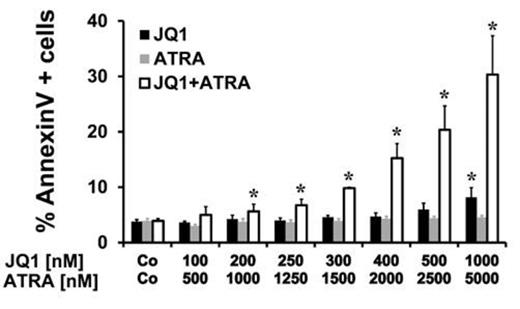Abstract
Advanced mast cell (MC) neoplasms are characterized by uncontrolled growth and rapid expansion of neoplastic MC in various organ systems and a poor prognosis. In human patients, advanced systemic mastocytosis (SM) is rare and usually presents as aggressive SM (ASM) or mast cell leukemia (MCL). In canines, advanced MC tumors (MCT) are considered one of the most frequent skin tumors. Hence, so far, no effective treatment concept has been established for advanced MC neoplasms in humans or canines. This is due to the fact that neoplastic MC in advanced SM usually are resistant against various cytoreductive agents. Therefore, research is currently focusing on potential drug targets and the effects of novel targeted drugs on neoplastic MC. We have recently identified the bromodomain-containing protein-4 (BRD4) as a promising new drug target expressed by neoplastic cells in acute myeloid leukemia (Zuber et al, Nature 2011;478:524-528). In the present study, we examined BRD4 as a potential therapeutic target in human ASM and MCL, and canine MCT. As assessed by immunohistochemistry, neoplastic MC expressed substantial amounts of cytoplasmic and nuclear BRD4 in ASM and MCL, whereas in human indolent SM (ISM), MC expressed lower amounts of BRD4 or did not express cytoplasmic BRD4. The human MCL lines HMC-1.1 and HMC-1.2 as well as the canine mastocytoma cell lines NI-1 and C2, also expressed BRD4. In order to study the potential biological function of BRD4, we applied a BRD4-specific shRNA. The shRNA-induced knockdown of BRD4 was found to be associated with a markedly reduced proliferation of HMC-1 cells. Correspondingly, the BRD4-targeting drug JQ1 induced dose-dependent growth inhibition in all MC lines examined, with higher IC50 values obtained in HMC-1.1 cells (IC50: 1.0 µM) and HMC-1.2 cells (IC50: 1.0 µM) compared to NI-1 cells (0.2 µM) and C2 cells (0.5 µM). As assessed by morphology and AnnexinV/PI staining, the growth-inhibitory effects of JQ1 on neoplastic human and canine MC lines were accompanied by apoptosis (Figure). The apoptosis-inducing effects of JQ1 was also demonstrable by staining for active caspase 3. Furthermore, JQ1 was found to downregulate the expression of the activation-related MC antigen CD63 and the proliferation-related antigen CD71 (transferrin receptor) in HMC-1 cells. In addition, JQ1 was found to inhibit proliferation in primary neoplastic MC obtained from patients with ASM or MCL (IC50 0.1-0.5 µM). We next screened for potential drug partners that would potentiate the anti-neoplastic effects of JQ1. Of all drugs tested, all-trans retinoic acid (ATRA) and PKC412 were identified as most potent drug partners of JQ1. These drugs were found to act highly synergistic with JQ1 in producing apoptosis and growth inhibition in HMC-1.1 and HMC-1.2 cells (Figure). Together, BRD4 is a novel marker and promising target in advanced MC neoplasms. Whether JQ1 or other BET bromodomain inhibitors are effective in vivo in patients with advanced SM or canine MCT remains to be elucidated.
HMC-1.2 cells were incubated in control medium (Co) or in various concentrations of JQ1 (black bars), ATRA (gray bars), or a combination of both agents at a ratio of 1:5 (white bars) at 37°C for 48 hours. Then, AnnexinV/propidium iodide (PI) staining was performed. The percentage of AnnexinV+ cells was determined by flow cytometry. Results represent the mean±S.D. of 3 independent experiments. Asterisk (*): p<0.05 compared to control (Co).
Bradner:Tensha Therapeutics: Dr. Bradner is a scientific founder of Tensha Therapeutics, which is developing drug-like derivatives of the JQ1 bromodomain inhibitor as cancer therapeutics, through a license from the Dana-Farber Cancer Institute. Other. Horny:Novartis : Consultancy, Honoraria.
Author notes
Asterisk with author names denotes non-ASH members.


This feature is available to Subscribers Only
Sign In or Create an Account Close Modal